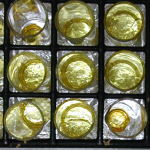
Biochemical sensors are used in clinical diagnostics, the pharmaceutical industry, environmental pollutant monitoring, food analysis, and detection of biological warfare agents. A biochemical sensor incorporates a biochemical recognition element along with a physical or chemical transducer. The recognition element must be specific to the target analyte and stable in a wide variety of environments. Recognition elements using immunosensors (e.g., antibodies) have excellent specificity and sensitivity, but require specific antibody synthesis, have sterilization problems, and may suffer from stability problems. Various biomimetic sensors have been developed that alleviate one or more of these problems. Sensors based on molecularly imprinted polymers (MIPs) are of particular interest.
The recognition properties of MIPs arise from the way they are prepared. During synthesis, functional and crosslinking monomers are copolymerized in the presence of a target analyte (imprint molecule) that acts as a molecular template. The monomers are chosen for their ability to interact with the functional groups of the template molecule. Polymerization/crosslinking yields a network polymer with the template molecules incorporated. After the extraction of template molecules, the resulting cavities retain their ``memory'' for the target analyte. MIPs are robust, stable, and resistant to a wide range of pH, humidity, and temperature. MIPs are also relatively inexpensive to produce and can be synthesized for analytes for which no natural antibody exists.
Fluorescence emission of trapped analytes in the polymer matrix is typically used to detect analyte concentrations. To create practical sensing devices, the complex interplay of the factors affecting detection need to be understood. To this end, we are collaborating with Mingdi Yan at Portland State University to examine various optical issues that affect the sensitivity of a fluorescence-based MIP sensor to facilitate rational design of future MIP sensors.
2006Y.-C. Chen, Z. Wang, M. Yan, S. A. Prahl, "Fluorescence Anisotropy Study of Molecularly Imprinted Polymers," Luminescence, 21, 7-14 (2006).
2004Y.-C. Chen, J. Brazier, M. Yan, S. A. Prahl, "Steady-State Fluorescence Anisotropy Studies Of Molecularly Imprinted Polymer Sensors," Proceedings of the Oregon Academy of Science, 40, 49 (2004 abstract only).
Y.-C. Chen, J. J. Brazier, M. Yan, S. A. Prahl, "Fluorescence-Based Optical Sensor Design for Molecularly Imprinted Polymers," Sensors and Actuators B: Chemical, 102, 107-116 (2004).
Y.-C. Chen, J. J. Brazier, M. Yan, S. A. Prahl, "Evaluation of Molecularly Imprinted Polyurethane as an Optical Waveguide for PAH Sensing," SPIE Proceedings in Nanosensing: Materials and Devices Symposium, 5593, 513-520 (2004).
2003Y.-C. Chen, J. Brazier, M. Yan, S. A. Prahl, "Optical Molecularly Imprinted Polymer Sensors," Proceedings of the Oregon Academy of Science, 39, 37 (2003 abstract only).
Y.-C. Chen, Z. Wang, M. Yan, S. A. Prahl, "Steady-State Fluorescence Anisotropy Studies of Molecularly Imprinted Polymer Sensors," Materials Research Society Proceedings of Organic, Soft, and Biological Materials --- Molecularly Imprinted Materials, 787, (2003).
2002J. J. Brazier, M. Yan, S. A. Prahl, Y.-C. Chen, "Molecularly Imprinted Polymers Used as Optical Waveguides for the Detection of Fluorescent Analytes," Materials Research Society Proceedings of Molecularly Imprinted Materials-Sensor and Other Devices, 723, 115-120 (2002).